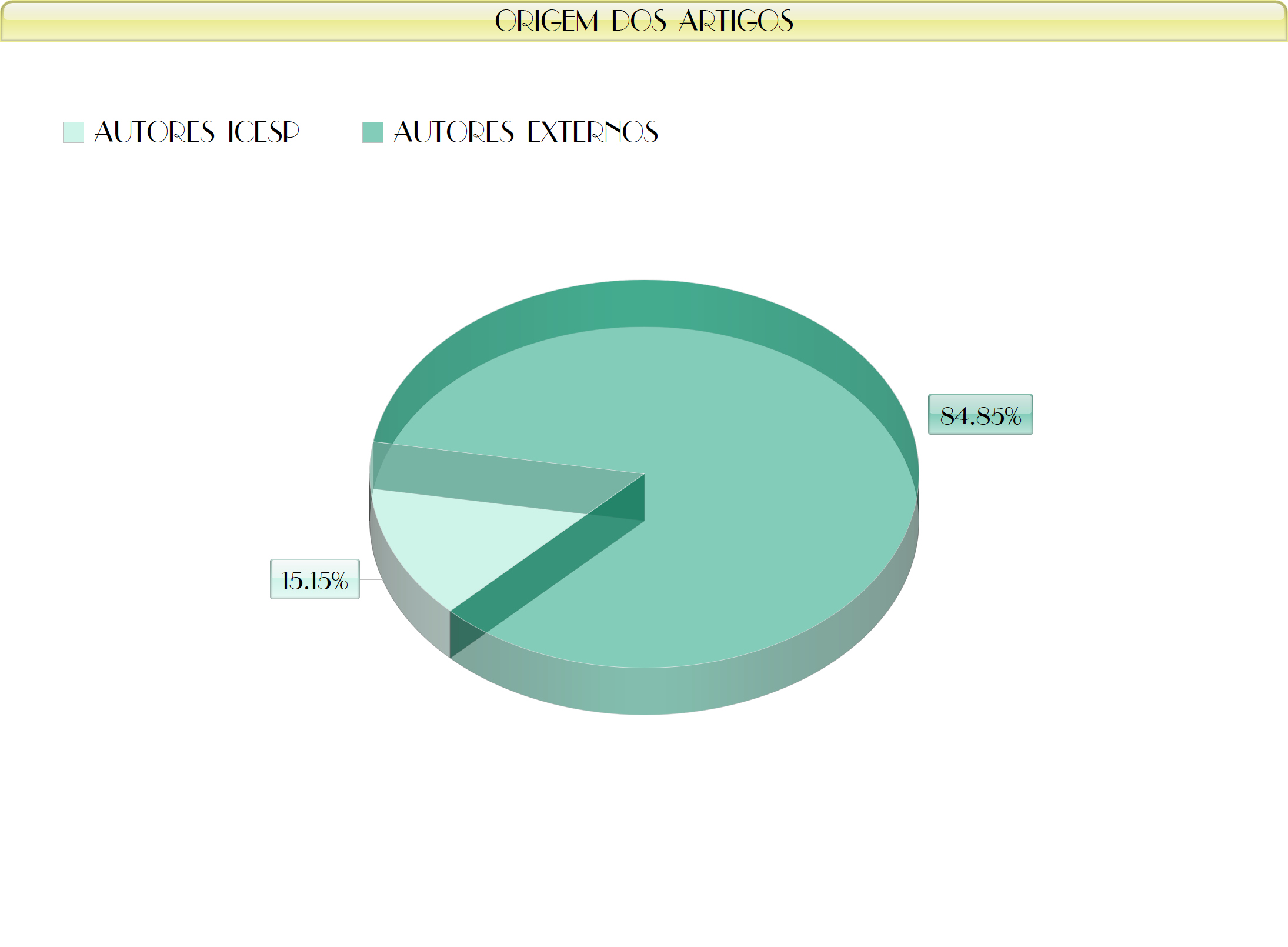RELAÇÃO EXISTENTE ENTRE BIOFILMES BACTERIANOS, QUORUM SENSING, INFECÇÕES E RESISTÊNCIA A ANTIBIÓTICOS: UMA REVISÃO BIBLIOGRÁFICA
Resumo
Resumo
Este trabalho aborda a relação do quorum sensing na formação do biofilme bacteriano. O quorum sensing é um mecanismo de comunicação bacteriano, envolvido na expressão de fatores de virulência e formação de biofilme. Desse modo, impedir o funcionamento do quorum sensing é uma estratégia para contenção do biofilme. O biofilme é descrito como um aglomerado de células bacterianas ancoradas irreversivelmente a uma superfície inerte ou viva. Quando formado, o biofilme ocasiona/agrava infecções, e devido a sua estrutura tridimensional, dificulta o tratamento com antimicrobianos, promovendo a resistência aos mesmos.
Palavras-chave: Biofilme; resistência; quorum sensing; infecção.
Abstract
This work addresses the relationship of quorum sensing in the formation of bacterial biofilms. The quorum sensing is a mechanims of bacterial communication, envolving the expression of virulence factors and the biofilm formation. Therefore, hindering the operation of quorum sensing is an strategy to control biofilm. The biofilm is described as a cell pellet bacteria irreversibly anchored to an inert or living surface. Once formed, biofilms cause/aggravate infections, and also, due to its three-dimensional structure, it hinders the antimicrobial treatment, promoting antimicrobial resistance.
Keywords: Biofilm; resistance; quorum sensing; infections.
figshare DOI: 10.6084/m9.figshare.9788858
Texto completo:
PDFReferências
– PÁDUA, Melo et al. Biofilme em rinossinusite crônica com polipose nasossinusal: estudo piloto.BRAZILIAN JOURNAL OF OTORHINOLARYNGOLOGY, v. 75, n. 6, p. 788-93, 2009.
– COSTERTON, J. W.; STEWART, Philip S.; GREENBERG, E. P. Bacterial biofilms: a common cause of persistent infections. Science, v. 284, n. 5418, p. 1318-1322, 1999.3 - DONLAN, Rodney M. et al. Biofilms: microbial life on surfaces. Emerg Infect Dis, v. 8, n. 9, 2002.
- LERICHE, V.; SIBILLE, P.; CARPENTIER, B. Use of an enzyme-linked lectinsorbent assay to monitor the shift in polysaccharide composition in bacterial biofilms. Applied and environmental microbiology, v. 66, n. 5, p. 1851-1856, 2000.
- DONLAN, Rodney M. Biofilm control in industrial water systems: approaching an old problem in new ways. Biofilms: recent advances in their study and control. Amsterdam: Harwood Academic Publishers, p. 333-60, 2000.
- LEWANDOWSKI, Zbigniew; EVANS, L. V. Structure and function of biofilms. Biofilms: recent advances in their study and control, p. 1-17, 2000.
- JAMES, G. A.; BEAUDETTE, L.; COSTERTON, J. W. Interspecies bacterial interactions in biofilms.Journal of Industrial Microbiology, v. 15, n. 4, p. 257-262, 1995.
- DONLAN, Rodney M. Role of biofilms in antimicrobial resistance. ASAIO journal, v. 46, n. 6, p. S47-S52, 2000.
– GALANTE, Joana et al. Quorum sensing and biofilms in the pathogen, Streptococcus pneumoniae. Current pharmaceutical design, v. 21, n. 1, p. 25-30, 2015.
- HAUSNER, Martina; WUERTZ, Stefan. High rates of conjugation in bacterial biofilms as determined by quantitative in situ analysis. Applied and Environmental Microbiology, v. 65, n. 8, p. 3710-3713, 1999.
– GHIGO, Jean-Marc. Natural conjugative plasmids induce bacterial biofilm development. Nature, v. 412, n. 6845, p. 442-445, 2001.
– ROMERO, Manuel; ACUÑA, Laura; OTERO, Ana. Patents on quorum quenching: interfering with bacterial communication as a strategy to fight infections. Recent patents on biotechnology, v. 6, n. 1, p. 2-12, 2012.
- KALIA, Vipin Chandra; RAJU, Sajan C.; PUROHIT, Hemant J. Genomic analysis reveals versatile organisms for quorum quenching enzymes: acyl-homoserine lactone-acylase and-lactonase. The open microbiology journal, v. 5, p. 1, 2011.
- ZHANG, Rong-guang et al. Structure of a bacterial quorum-sensing transcription factor complexed with pheromone and DNA. Nature, v. 417, n. 6892, p. 971-974, 2002.
– PEARSON, James P.; PESCI, Everett C.; IGLEWSKI, Barbara H. Roles of Pseudomonas aeruginosa las and rhl quorum-sensing systems in control of elastase and rhamnolipid biosynthesis genes. Journal of Bacteriology, v. 179, n. 18, p. 5756-5767, 1997.
- DE KIEVIT, Teresa R.; IGLEWSKI, Barbara H. Bacterial quorum sensing in pathogenic relationships. Infection and Immunity, v. 68, n. 9, p. 4839-4849, 2000.
- OLSON, Michael E. et al. Staphylococcus epidermidis agr Quorum-Sensing System: Signal Identification, Cross Talk, and Importance in Colonization. Journal of bacteriology, v. 196, n. 19, p. 3482-3493, 2014.
- HUME, E. B. H. et al. The control of Staphylococcus epidermidis biofilm formation and in vivo infection rates by covalently bound furanones.Biomaterials, v. 25, n. 20, p. 5023-5030, 2004.
– RUTHERFORD, Steven T.; BASSLER, Bonnie L. Bacterial quorum sensing: its role in virulence and possibilities for its control. Cold Spring Harbor Perspectives in Medicine, v. 2, n. 11, p. a012427, 2012.
– SOLA, Marília Cristina et al. Mecanismos de Quorum Sensing e Sua Relevância na Microbiologia de Alimentos. Enciclopédia Biosfera, v. 8, n. 14, p. 1419-1441, 2012.
– VIDAL, Jorge E. et al. Quorum-sensing systems LuxS/autoinducer 2 and Com regulate Streptococcus pneumoniae biofilms in a bioreactor with living cultures of human respiratory cells.Infection and immunity, v. 81, n. 4, p. 1341-1353, 2013.
- RAUT, Nilesh; PASINI, Patrizia; DAUNERT, Sylvia. Deciphering Bacterial Universal Language by Detecting the Quorum Sensing Signal, Autoinducer-2, with a Whole-Cell Sensing System.Analytical chemistry, v. 85, n. 20, p. 9604-9609, 2013.
– WOODWORTH, Bradford A. et al. An in vitro model of Pseudomonas aeruginosa biofilms on viable airway epithelial cell monolayers. American journal of rhinology, v. 22, n. 3, p. 235-238, 2008.
-. TIBA, Monique Ribeiro; NOGUEIRA, Gustavo Prado; LEITE, Domingos da Silva. Estudo dos fatores de virulência associados à formação de biofilme e agrupamento filogenético em Escherichia coli isoladas de pacientes com cistite.Revista da Sociedade Brasileira de Medicina Tropical, v. 42, n. 1, p. 58, 2009.
- ANTUNES, Luis Caetano M. A Linguagem das bactérias. Ciência hoje, v. 33, n. 193, p. 16-20, 2003.
–LIN, Yi‐Han et al. Acyl‐homoserine lactone acylase from Ralstonia strain XJ12B represents a novel and potent class of quorum‐quenching enzymes.Molecular microbiology, v. 47, n. 3, p. 849-860, 2003.
- Steggles RS. Composition comprising garlic extract and an antibiotic and/or antiseptic for use in the treatment of a multispecies bacterial infection. GB2472315A, 2011.
– PECHERE, Jean-Claude; VAN DELDEN, Christian; MENEKSE, Oktay. Therapeutic process for p. aeruginosa infections using macrolide antibiotics. U.S. Patent Application 10/485,282, 3 set. 2001.
– HENTZER, Morten; GIVSKOV, Michael. Pharmacological inhibition of quorum sensing for the treatment of chronic bacterial infections. Journal of Clinical Investigation, v. 112, n. 9, p. 1300, 2003.
- REN, Dacheng et al. Differential gene expression shows natural brominated furanones interfere with the autoinducer‐2 bacterial signaling system of Escherichia coli. Biotechnology and bioengineering, v. 88, n. 5, p. 630-642, 2004.
– ALASIL, Saad Musbah et al. Inhibition of Quorum Sensing-Controlled Virulence Factors and Biofilm Formation in Pseudomonas aeruginosa by Culture Extract from Novel Bacterial Species of Paenibacillus Using a Rat Model of Chronic Lung Infection. International Journal of Bacteriology, v. 2015, 2015.
- BEVER, Robert A.; IGLEWSKI, Barbara H. Molecular characterization and nucleotide sequence of the Pseudomonas aeruginosa elastase structural gene. Journal of bacteriology, v. 170, n. 9, p. 4309-4314, 1988.
- BRACKMAN, Gilles; COENYE, Tom. Quorum Sensing Inhibitors as Anti-Biofilm Agents. Current pharmaceutical design, v. 21, n. 1, p. 5-11, 2015.
Apontamentos
- Não há apontamentos.
Revista Brasileira de Pesquisa em Ciências da Saúde - RBPeCS - ISSN: 2446-5577
Indexadores:













